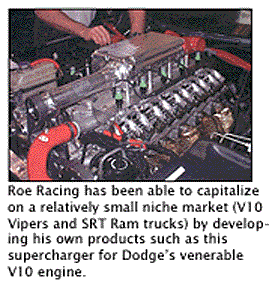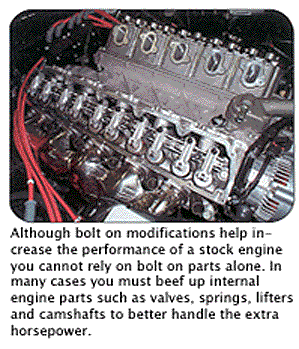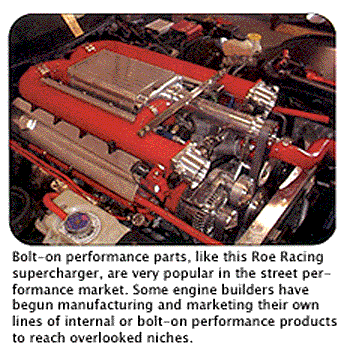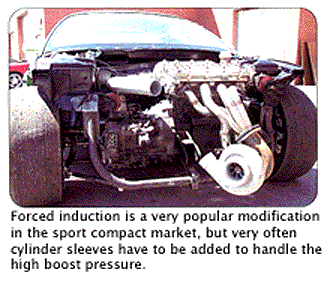Let’s face it: stock engines just don’t wear out – at least not until upwards of 150,000 miles for the average late model engine. Sure, neglect continues to take its toll, but on the whole, while there is still some stock rebuilding work to be had, it’s not what it used to be.
Have you grown tired of waiting for the stock engine work to come through your door?
Building performance street engines requires many of the same skills, resources and attention to detail as building a racing engine, but without the same stress and strain on both engine builder and engine components. However, that doesn’t mean this market is a walk in the park. Getting involved in any niche market requires doing lots of homework up front to determine if it’s right for you and your shop.
According to the latest statistics from the Engine Rebuilders Association (AERA), nearly 80 percent of engine builders do performance work in some way, shape or form. But performance comes in many forms, which, simply put, means there are many specialized niches within this broad category.
Determining what opportunities exist in performance street applications is an individual exercise. But for those with the passion to make things go fast as well as the ability to learn fast – building beefed-up street engines can be profitable and rewarding.

Generation Gap
According to some experts, there are basically two groups comprising the street performance market today: 18-25 year old Gen Y’s and their love of all things compact (as in sport compact); and the baby boomers and their muscle cars. The boomers are now either retiring or finally able to spend freely after years of raising kids and putting them through school. Many boomers have finally gotten to the point where they want to live out their muscle car dream fantasies.
“Most of the people buying muscle cars to restore are in their 40s or older and have held a steady job for many years,” explains Kevin Frische, Kalvinator Engines in Wapakoneta, OH. “The house is paid for, the kids are out of school, and finally dad finds that car he always wanted way back in high school. Only now he can afford it.”
Frische believes that the “want” far outweighs the “need” or even the “can,” in many of these cases, which makes for an attractive combination for an intrepid engine builder. “The money is secondary to him, and most of these guys don’t know how to work on cars at all, let alone build an engine. This market interests us very much,” Frische says.
On the other side of the demographic coin is the Gen X-Y’ers who have typically been interested in tricked out sport compact rides. To many engine builders, street performance has traditionally meant small block Chevy, but that’s not really the case anymore. In much of the country, the sport compact craze is just starting to hit its stride. “When most people were talking about all the Honda engines that were being built a few years ago, my shop in rural Ohio didn’t get any of them,” says Frische. “But just recently that has started to change. We are now starting to see some of the ‘tuner’ cars that everyone has been talking about in other parts of the country. It’s just starting to hit the cornbelt.”
According to the Specialty Equipment Marketing Association (SEMA), the market for tuner cars generally consists of young males between 18- and 25-years-old. They typically purchase their cars used and modify them slowly – as in paycheck to paycheck. Some have compared the trend of young people “sooping” up their hand-me-down vehicles to the hot rod era of the ’60s. However, one of the biggest differences between this market and the hot rodders is the amount of female participation. Nearly 18 percent of the sport compact market are female enthusiasts, according to SEMA. Another interesting note about this market is where they spend their dollars: more than 31 percent say they spent their money on engine parts and enhancements.

Tuners
Much has been said about “tuners” in this magazine in recent years, but what can’t be emphasized enough is that there is opportunity in this market for engine builders who are passionate about it and are willing to put in the time educating their customers on the need to do things right. Some of these compact engines can produce up to 300 hp naturally aspirated and over 450 hp with a turbo or supercharger. That’s a lot of power from engines that typically may only produce up to 160 hp bone stock. But to get this kind of power you must be able to maximize airflow and compression. Reworking cylinder heads for better airflow involves many of the same tricks, such as porting the heads, installing oversize valves and increasing lift and duration, which work so well on traditional V8s.
Becoming a tuner is a little more encompassing than just doing machine work. Sean Roe of Roe Racing in Jacksonville, FL, started out tuning Vipers in his very small one-man shop. As a former IMSA Supercar race winner, Roe saw the need for performance Viper parts but because very little was available, he set out to change that. His business has grown to include nine employees in a much larger shop. While business includes building engines for a few select customers, most of what he does is develop new parts including a supercharger and engine management system for the Dodge V10 engines in Vipers and Ram SRT-10s.
“Predominantly, the Vipers have gotten us to where we are now but since last year, when Dodge started selling the Ram SRT-10, the V10 pickup engine has become an important part of our business,” says Roe. “We’ve got over 700 engine management systems out in the market now. The system, which we have slowly developed over the years, is not a piggyback or a stand-alone, it’s truly an in-series system. We let the stock PCM see all of its normal signals unless we want to limit it just to keep the check engine lights off. When it sends an output signal to drive an injector that signal goes into our system where it deadends and sends a spike signal to the stock PCM, which thinks it just pulsed an injector.”

Bolt-Ons
Bolt-on engine modifications are big right now, according to industry experts. This fact is not lost on some engine builders. Marco Passante of Magnus Motorsports in Ontario, Canada says that his company has shifted its focus from building sport compact engines to manufacturing bolt on parts. “We’ve moved more into manufacturing the last couple of years, and we are always trying to stay a step or two ahead of the curve. We have done a lot of development on the Mitsubishi 4G63 engine and manufacture many bolt-on performance parts for that engine as well as others. We are very focused on intake manifolds right now because we’re able to make an extra 40 hp with our modifications.”
One of the biggest challenges Passante says he faces is protecting his designs from copycats. He says he often has to spend time on the phone with his lawyer trying to put a stop to someone ripping off one his designs. This is a difficult market in that sense but he says the key is to stay a step ahead to be profitable.
SEMA reports that engine modifications – internal and external – are the second largest segment of the sport compact market. The products in this segment include ignition coils, sparkplug wires, turbos and superchargers, cold-air intakes, nitrous, headers, cat-back exhaust systems as well as engine hose kits. Also included in this category are internal engine modifications such as cylinder sleeves, connecting rods and pistons.
Manufacturing
If you have a CNC machine center and you aren’t yet manufacturing bolt-on components you may be missing a potential cash cow. Even if you don’t have a CNC you could still cash in. Doing development work on popular sport compact and street rod engines may be a side business opportunity for your shop. Roe Racing and Magnus Motorsports as well as others have recognized this fact. If there is an area of performance you are particularly interested in you may be able to manufacture components for these engines and sell them to enthusiasts through mail order.
“We have had to manufacture things for the Vipers where parts didn’t exist before, and we’ve had to do a lot of problem solving on our own,” says Roe. “I’ve had to go to different places to get products or have products made, but the investment has paid off in products that we can sell.”
Muscle Cars

For engine builders looking for something a bit different but not too different, muscle car restorations have been making a comeback and offer an opportunity for shops to branch out into the performance market without straying too far from their domestic V8 engine roots.
One engine builder noted that most of his customers for high performance street engines couldn’t change a spark plug if their lives depended on it. However, these same customers know what they want from reading magazines and watching the new crop of reality automotive shows on television.
Customers may often speak the language but not really understand what they are saying. Consequently, some shops use the dyno to tell the story of that particular engine because the engines are not put into the heat of battle at a racetrack. Customers in this market want to know the numbers and how much horsepower the engine has so they can tell their friends.
Engine builders we have spoken to say success in this market is possible only if you are up front with customers about the components you’re using and the horsepower ratings, because nothing will ruin your reputation quicker than bogus claims. Another thing to remember is that while the amount of expertise may be low, some of your customers are as familiar with the tolerances as you are, and if you do performance machining for other speed shops they are going to check your work to make sure it’s what they want. Even if you do everything right, you may still get complaints, say experts, but that’s just the way it is. However, if you do everything right and show up front what you are doing you will get business and your reputation will grow accordingly.
Muscle cars owners are not just the over-40 crowd anymore. According to many experts in the field, there is also new generation of enthusiasts. These enthusiasts want performance to match the looks of the vehicle. And, for the most part, they have the money to spend to make it perform as well as it looks.
Chassis Dynos
Most tuners these days use a chassis dyno not only to prove to customers but also for their own development of specific products. A chassis dyno can be an invaluable tool for not only testing your bolt-on and internal engine modifications but also for testing engine management fuel maps.
Magnus’s Passante says his shop dyno tests all of the components they manufacture before they sell them “We designed and tested a couple of different Mistubishi 4G63 blocks with taller decks and different stoke cranks and things like that. We use the dyno quite a bit.”
Kalvinator’s Frische says that he hasn’t purchased a chassis dyno yet but likes the idea of being able to sell new services to performance customers. “I can sell dyno services to my customers and tune cars on it and then give them a piece of paper afterwards to show them whether the upgrade was worth it.”
Having a chassis dyno is almost a necessity when making changes to the ECU. Chip tuners often make changes to the fuel mapping software and then run it on the dyno to see what affect the changes made.
Whether you prefer to stick with just the machine work or branch out into other areas like manufacturing and tuning, there are many opportunities for engine builders involved with building street performance engines. There are more than a few aftermarket suppliers who are chomping at the bit to sell you parts for these engines. One cam supplier has over 200 part numbers for street performance engines alone.
Nobody is abandoning the small block Chevy but in our competitive market there is always pressure to look for new opportunities.
Building a reliable, daily driven, street performance engine requires a lot of expertise and know how to do it well. The challenge is in the education. You can’t turn a stock engine into a serious high performance street monster with bolt-on accessories alone, you have to open it up and make internal modifications as well. But one of your most challenging jobs is likely going to be to inform your customers of their options – and limitations.













